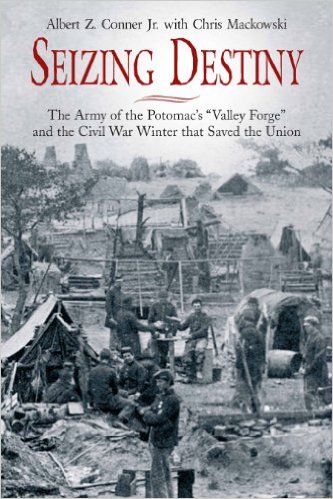Book Review: “Seizing Destiny: The Army of the Potomac’s ‘Valley Forge’ and the Civil War Winter that Saved the Union”.
After the Federal disaster at Fredericksburg in December, 1862, President Abraham Lincoln moaned, “If there is a place worse than hell, I am in it.” The Union war effort, at least in the east, had been met repeatedly with setbacks, and the latest defeat came at a time when Lincoln hoped to drive home his ultimatum with the upcoming Emancipation Proclamation.
If Lincoln was in hell, what of the Army of the Potomac, the Union’s fighting force in the east? Fredericksburg marked the darkest period for the army during the entire Civil War, and they went into winter quarters in nearby Stafford County a nearly broken lot. And yet, just a few months later, the army went on to fight Robert E. Lee at Chancellorsville, and though a defeat, the Federals absorbed the loss and, two months later, win the battle of Gettysburg. What happened in Stafford County is the subject of a new book, Seizing Destiny: The Army of the Potomac’s “Valley Forge” and the Civil War Winter that Saved the Union.
Authored by Albert Conner and Chris Mackowski, Seizing Destiny is the perfect book to explain what is usually shrugged off as “Joseph Hooker replaced Ambrose Burnside, and fixed morale in the army.” How? remained the pertinent question for historians to answer in the interlude between Fredericksburg and Chancellorsville, and Conner and Mackowski answer the question and then some.
Brimming with first-hand accounts, the two authors allow the soldiers and officers of the Army of the Potomac to do a lot of the explaining. Reading the letters, one can trace as the army starts to believe in itself again—humor replaces deep skepticism, and the soldiers start to look forward to their next engagement with Lee’s men to try and prove what they were capable with. These primary sources are drawn from all over the army, allowing for a full panoramic view of the Army of the Potomac.
Though not fully focused on battles, the two authors do go into detail of the cavalry actions in the winter and early spring of 1863, culminating with the battle of Kelly’s Ford on March 17, 1863, St. Patrick’s Day. There are plenty of maps to allow the reader to follow along.
If the book will have its naysayers, they will come against the book’s subtitle, claiming the winter of 1862-63 to be the “Valley Forge” of the Federal army. The authors are fully aware of what a large claim this is, and they rely on soldiers like Rufus Dawes from the famed Iron Brigade, whose own writings allude to the Continental Army’s experiences in 1777-78 during the American Revolution in comparison to the Army of the Potomac. While not a perfect comparison (George Washington and his men were, after all, dealing with the loss of their own capital, something the Army of the Potomac didn’t have against them), the allusion does have its points.
Seizing Destiny is a great resource for the Army of the Potomac scholar, or someone looking for that background information on the period between Fredericksburg and Chancellorsville. It is truly an unfortunate case that one of the book’s authors—Al Conner—recently died after a long fight against cancer. But Conner’s contribution to the Civil War scholarship alongside Mackowski, a topic that sometimes seems maxed out, is a lasting one that readers will pick up for years to come.
Albert Z. Conner Jr., with Chris Mackowski
Seizing Destiny: The Army of the Potomac’s “Valley Forge” and the Civil War Winter that Saved the Union.
Savas Beatie, 2016.
369 Pages
Footnotes, 3 Appendices, Bibliography, Index.

Thanks Ryan. I hope, if you have not yet done so, you get them up on Amazon and copy to BN.com as well.